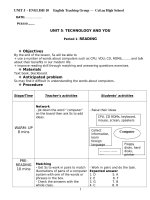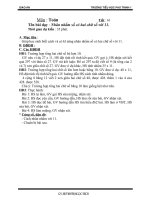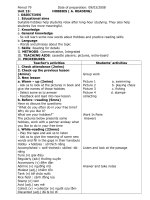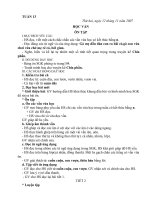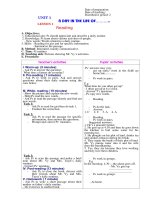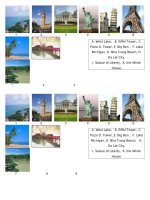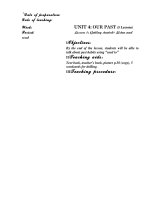giao an Unit 13
Bạn đang xem bản rút gọn của tài liệu. Xem và tải ngay bản đầy đủ của tài liệu tại đây (47.3 KB, 3 trang )
<span class='text_page_counter'>(1)</span><div class='page_container' data-page=1>
Unit 13
Date of preparing:
Date of teaching:
Class:10A8
Period: 1
A. READING
<b>I. AIMS AND OBJECTIVES:</b>
<i>- Language content:</i>
+ To introduce the students some new words related to films and cinema
<i>- Language function: </i>
+ To talk about films and cinema
<i>- Educational aims:</i>
+ To make students aware of the importance of films and cinema in daily life
+ To educate sts to watch suitable films.
<b>1. Language:</b>
<i>a.Vocabulary</i>: motion,set st in motion,still,audience,spread,replace,
<i>b.Structures</i>:
<b>2. Skills:</b> Intergrated skill.
<b>3. Education factor :</b>
+ Students students will be able to get information about films and cinema.
<b>II. TEACHER AND STUDENTS’ PREPARATION</b>:
<b>1. Method:</b> Communicative approach
<b>2. Techniques:</b> Explanation, Repetition, using pictures, group work, pairwork, multiple choice,
<b>3. Materials needed</b>: textbook, pictures
<b>4. Students preparation: </b>Prepare some pictures and information about them.
<b>III. PROCEDURE IN CLASS: </b>
1. <i>Stabilization: </i>- Greeting.
<b> </b> <b> </b>- Checking attendance
2. <i>Checking up the previous knowledge:</i>
- Asks Students to make sentences using “to-infinitive” and give an example
- Students answer.
<b>Teaching steps</b>
<b>and time</b> <b>Teacher’s activities</b> <b>Students’<sub>activities</sub></b> <b>The lesson content</b>
<b>I.Presentation</b>
<b> * Lead-in</b>
<b> * Pre-reading</b>
-uses some pictures to lead to
the new lesson
-makes some questions and
has sts answer.
Eg: Do you want to see a film
at the cinema or on TV?Why?
Can you name some of
the flms you have seen ?
-uses pictures in the text book
to intruduce some more
information about films and
-answer
Yes,I want to see a
film at the cinema
because it’s more
interesting.
Eg:Chay an,Nhung
ngon nen trong
dem……
<b>Unit 13</b>
</div>
<span class='text_page_counter'>(2)</span><div class='page_container' data-page=2>
<b>* While-reading</b>
cinema
-gives some new words:
motion(n)
set st in (v)
still (adj)
audience :viewers(n)
spread (v)
replace (v)
pistures:films
- explains the new words by
giving definition or pictures
-may aks sts to make sentences
using the new words
-correts
-reads the new words and has
sts repeat
-calls some sts to read the new
words individually
-correts
-has sts read the passage in
silence and do the task in the
book
<b>Task 1: </b>
-explains the task.
-has sts find out the kind of the
missing words in each
sentences.
-asks sts to work individually.
-has them exchange the
answers.
-calls some sts to do exercises
-correts
<b>Task2:</b>
-has sts read the text again and
work in pairs to answer the
questions.
-calls some pairs to ask and
answer
-corrects
<b>Task 3:</b>
-has sts work in pairs to decide
-take note
-make sentence
Eg: The cinema
fulls of audience.
-read the new
words individually
-read the passage
in silence
-listen
-work individually
-read the text
again and work in
pairs
-ask and answer
-work in pairs
1.New words
chuyển động
dịch chuyển
yên lặng
khán giả
lan rộng
thay thế
Eg: The cinema fulls of
audience.
<b>Task 1: </b>
1.cinema
2.sequence
3.decade
4.rapidly
5.scene
6.character
<b>Task2:</b>
1 in the early. 19th <sub>century</sub>
2.at that time the scientists
discovered that when a
sequence of still pictures was
set in motion ,they should
give feeling of movement.
3.No,they didn’t
4. in the early1910s
5.at the end of the 1920s
6.the musical cinema
<b>Task 3:</b>
</div>
<span class='text_page_counter'>(3)</span><div class='page_container' data-page=3>
<b>* Post-reading</b>
<b>II.Consolidation</b>
<b>III. Homework</b>
the best tittle for the passage.
- -makes some more questions
to ask the reason.
-corrects
- explains the task.
-does the first as a model
19th century: history of
cinema began
-has sts work in groups
- Calls some students to
answers in front of the class.
-Gives feedback and corrects
- Retells the content of the
text.
- Asks them to prepare the new
lessons at home andraed the
text again
-work in groups
-answers
-Eg: 1910s:The
first long film was
made
passage:
B.A Brief History of Cinema
<b>Self – evaluation </b>
</div>
<!--links-->
